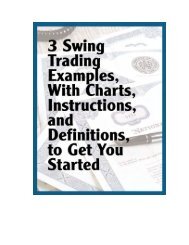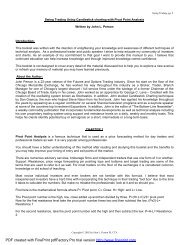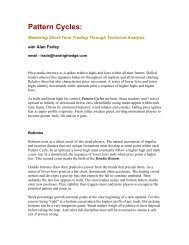To all those who did not dedicate - The Swing Trading Guide
To all those who did not dedicate - The Swing Trading Guide
To all those who did not dedicate - The Swing Trading Guide
Create successful ePaper yourself
Turn your PDF publications into a flip-book with our unique Google optimized e-Paper software.
A Practical <strong>Guide</strong> to <strong>Swing</strong> <strong>Trading</strong> by Larry <strong>Swing</strong><br />
Short selling is a marginable (???) transaction. In plain English, that means you must<br />
open a margin account to sell short. This is the same account you would use if you<br />
want to use your stocks as collateral to borrow money from your broker.<br />
When you open a margin account, you must sign a hypothecation / rehypothecation<br />
agreement. This hypothecation agreement says you will pledge your stocks as<br />
collateral against your loan. <strong>The</strong> re-hypothecation agreement <strong>all</strong>ows your broker to<br />
loan your stocks to a bank, or to other customers!<br />
12.1.3 How Do I Sell Short?<br />
Unlike a stock purchase transaction, which involves two parties (the buyer and the<br />
seller), short selling involves three parties: the original owner, the short seller, and<br />
the new buyer. <strong>The</strong> short seller borrows shares from the original owner, and<br />
immediately sells them on the open market to any willing buyer. <strong>To</strong> finalize ("close<br />
out") the short sale transaction, the short seller must then go out into the stock<br />
market and buy the same amount of shares as he sold so that the broker can return<br />
them to the original owner.<br />
<strong>To</strong> sell short you first must set up a margin account with your broker. A margin<br />
account <strong>all</strong>ows you borrow from your brokerage company using the value of your<br />
portfolio as collateral. <strong>The</strong> general rule is that the value of your portfolio must equal<br />
at least 50% of the size of the short sale transaction. In other words, If you have<br />
$1,000 worth of stock in your margin account, you can borrow $2,000 of stock to sell<br />
short.<br />
<strong>To</strong> sell a stock short, you must borrow stock. <strong>To</strong> initiate a short sale, you simply c<strong>all</strong><br />
up your broker and ask to sell short a specific number of shares of your selected<br />
stock. Your broker then checks with the Margin Department to see whether the<br />
shares are available or can be borrowed from a<strong>not</strong>her brokerage, usu<strong>all</strong>y while you<br />
wait on the phone for a minute. If they are available, the brokerage borrows the<br />
shares, sells them in the open market, and puts the proceeds into your margin<br />
account. <strong>To</strong> close out your short sale, you tell your broker that you want to buy the<br />
same number of shares that you shorted. <strong>The</strong> broker will purchase the shares for<br />
you using the money in your margin account, return the shares and close out the<br />
short sale transaction.<br />
While your short sale is outstanding, your account will be charged interest against<br />
the value of the short position. If the stock you shorted goes up in price, or the value<br />
Visit: http://www.mrswing.com/ or email: larry@mrswing.com












